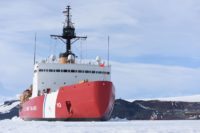The Coast Guard has set an unrealistic schedule for completing new heavy polar icebreakers, which could lead to design flaws and add to the estimated $9.8 billion cost of adding three new vessels to the service’s polar operations.
This was the conclusion of a report by the General Accountability Office, the investigative arm of Congress, that was discussed last week at a congressional hearing.
It said baselines were set before a preliminary design review was done, which could produce unstable design and increased costs. A technology readiness assessment wasn’t completed to determine maturity of key technologies, and the cost estimate didn’t take into account possible costs over the entire life of the program, thus compromising its reliability and potentially underestimating the total funding needed. In addition, planned delivery dates were “driven by the potential gap in icebreaking capabilities instead of being informed by a realistic assessment of shipbuilding activities.”
An unrealistic schedule “puts pressure on the Coast Guard to take shortcuts,” Marie Mak, director of GAO’s Acquisition and Sourcing Management Office told the House Coast Guard and Maritime Transportation subcommittee hearing.
And a tight construction schedule leaves little time to review vessel performance, presenting the risk “of transmitting design problems from one (vessel) to another,” added Ronald O’Rourke, specialist in Naval Affairs at the Congressional Research Service.
But Rear Adm. Michael J. Haycock, assistant commandant for Acquisition and Chief Acquisition Officer, said the Coast Guard is “planning to be successful” with the project. “I’m confident we’ll have a design of a high level of maturity before we start cutting steel,” he said in response to questions from lawmakers. “We have conducted industry studies over the past five years and this has informed designs. Our next step is detailed design.”
The Coast Guard has been working for nearly a decade on a program to replace its two working polar icebreakers that are old and in need of constant, costly repairs. The 399’ Polar Star, a heavy icebreaker, is over 40 years old and in poor shape. Its primary mission is in Antarctica to resupply the McMurdo Research Station.The Polar Star arrived Tuesday at Pearl Harbor to begin preparations for its 2019 deployment to McMurdo.
The 420’ Healy, the nation’s only operational medium icebreaker, is 22 years old and supports scientific research and search and rescue missions in the Arctic.
As warming seas melt the polar ice, the Arctic is increasingly busy with commercial vessel traffic that can use northern shipping routes for longer periods of time. The unpredictability of the ice, however, creates more risks of shipping accidents. The area has also become a national security concern, as other countries like Russia are jockeying for dominance and are building up their influence and presence in the polar region.
In 2017, the Coast Guard contracted five shipyards to produce technical and pricing proposals on the icebreaker: General Dynamics, National Steel and Shipbuilding Co., Huntington Ingalls Industries, Bollinger, Fincantieri Marine Group and VT Halter Marine. U.S. yards have not built an icebreaker since the Healy was delivered from the Avondale Industries shipyard in New Orleans in 1999.
A design and construction contract is expected to be awarded for the first heavy icebreaker sometime next year, with delivery of the first vessel in late 2023.
The fate of funding for this vessel will be decided before Dec. 21, when Congress must complete action on seven federal spending bills. The Senate has included $750 million for the project but the House’s budget version for the Coast Guard does not. House lawmakers stripped funding for the icebreaker in favor of funding President Trump’s border wall. Negotiations on an agreement are underway.




